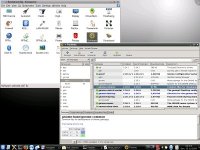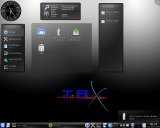Toorox
I was very excited when I read the release announcement for a new Linux distribution based on Gentoo Linux. I used Gentoo for several years and admire Sabayon Linux, so I was quite anxious to test another derivative. After all the testing I was pleased to find that Toorox 06.2009 delivers a true Gentoo experience but is much easier to install and use.
Introduction
Toorox Linux ships as a live DVD featuring KDE 4.2.4, Linux 2.6.28, and lots of useful applications. It uses KNOPPIX hardware detection, but what makes Toorox stand out is its extra tools and utilities.
One interesting feature set is the system installation tools. From the live DVD environment one can choose to install to a hard drive or USB stick. These tools aren't especially elaborate, but they get the job done. The best thing for me was the ability to install on a partition further down the disk than 16. One can select one of the listed partitions or input the desired number. Beyond the install partition the simple installer only asks for a user account, root password, and whether to install GRUB. What makes these installers outstanding is the fact that they work, which is a goal that Gentoo developers themselves continue to struggle with.
The Systemconfig browser contains links to KDE configuration tools such as the System Settings, desktop configuration module, Display options, Effects, and System Information. However, there's much more. One of the most handy additions is the "Driver, Multimedia" folder. This leads users to scripts that install proprietary graphic drivers, files and codecs for multimedia enjoyment, as well as the Adobe Flash browser plugin. So, while Toorox may not ship with these proprietary and closed-source files, it does provide an easy way to obtain them.
Portage

Portage is the Gentoo package manager that downloads, compiles, and installs source packages onto users' systems. Portage was the main feature of Gentoo that propelled it to popularity in the past, but massive emerge failures probably contributed to Gentoo's decline after the departure of Daniel Robbins. However, the development team has persevered and the stable software tree functions well today.
The best thing found in the Systemconfig browser is probably Porthole.
Porthole is a graphical front-end for Portage. I've tested several
graphical Portage front-ends over the years, but most are
disappointing. Porthole seems to be the most consistently stable and
reliable front-end I've used. It allows for the configuration of advanced
compiler options, similar to what one might set in the /etc/make.conf
file. It functions very much like Synaptic does for APT. It can list
packages by category, allows searching by package name, and all that's
required to install is right-clicking on the package name and selecting
"emerge" or
"pretend emerge". The latter doesn't install the package, but will provide
alerts for various problems that may be encountered when installing it for
real.
Unlike Sabayon, Toorox uses the Gentoo package tree and is fully compatible with Gentoo. This also means any updates will come straight from Gentoo. Portage in Toorox is set up to install from the unstable branch of software, probably to accommodate KDE 4 and its dependencies. The unstable branch includes the newest versions of software, sometimes beta, that may not compile or function properly.
Used as configured, Porthole had no problems installing individual packages without dependencies or desired packages with just a few dependencies, but new users may wish to avoid "update world" (synonymous with APT dist-upgrade).
Hardware Observations
Toorox ships with the main 2.6.28 Gentoo kernel. Gentoo has several kernel choices available such as a hardened kernel with extra security patches and higher security settings, a multimedia-oriented kernel, Xen, vanilla, TuxOnIce, and OpenVZ. All are highly patched except the vanilla sources and some are very specialized, such as the Xbox kernels.
Hardware support is thus up-to-par and sometimes surpasses that found with the vanilla kernel. Toorox uses the KNOPPIX hardware detection scripts and does an adequate job. Most hardware is autodetected and autoconfigured. Although battery monitoring was automatic, I needed to manually configure powersaving features.
On machines with at least 1 GB of RAM, Toorox performance was acceptable. However, on machines with, for example, 512 MB, Toorox was a bit slow. Internet connections with supported hardware and using the DHCP protocol were configured automatically. Screen resolution is chosen by the user at the start of the live DVD and passed on to the hard drive install, but a machine with dual monitors required manual configuration. In fact, I had to disconnect my secondary monitor in order to fully boot the live DVD or fresh install.
Interface and Software

Toorox has done a nice job of trying to make the desktop accommodating for new users. On the desktop is a widget that lists all the partitions that can be mounted and browsed in Dolphin with a single click. Another desktop widget features some helpful, if redundant, applications such as Starter, Systemconfig, File Manager (Dolphin), and the Terminal. One other contains connection information. The panels again house widgets and launchers for much the same: Starter, Systemconfig, Terminal, and Trash; with a few additions such as Iceweasel and Device Notifier.
Starter is a link to an application browser containing many of the applications Toorox developers think may be of particular interest to users. Toorox even comes with two menus. One is the newer KickOff menu popularized by openSUSE and now default in KDE and the other is a traditional category/list menu. No one should have any difficulties finding applications to use.
The Toorox image is 1.7 GB and contains lots of applications. The standards are there such as OpenOffice.org, the GIMP, KDE essentials, and lots of games. But there are lots of extras as well such as Wine, VLC, XChat, XSane, Epiphany, Debian's Iceweasel, and Qt Designer. There are thousands more in the Portage package tree.
Conclusion
All told, Toorox does a nice job of packaging up Gentoo, KDE 4, and a working installer to give an interesting and off-the-beaten-path Linux experience. There will always be niggles with Gentoo and so Toorox has its share - especially since it is using the unstable branch of software. But overall the system is stable, responsive, and just plain fun to use.
The default language for Toorox is German, but English is fully supported and easily chosen when booting the live DVD. Toorox has forums for user support, but they, too, are in German. Fortunately, for any issues I needed to resolve, the regular Gentoo forum was the answer. The best part about the Gentoo forum is that most questions have already been answered and are a mere search away.
Most of my recurring issues with Toorox are actually because of KDE 4. This is the best implementation of KDE 4 that I've tried, but, due to the way I work, I still had issues. Toorox developers have tried to make the KDE 4 desktop as usable as possible while making sure folks can find the modules needed to customize to their liking. For those without 50,000 email messages, 1,500 news feeds, and who don't accumulate too many open Konqueror windows, Toorox's KDE 4 could probably fill the bill. Under heavy loads KDE 4 performed rather poorly, even becoming completely unresponsive at times.
Toorox is ideal for someone who'd like to be introduced to Gentoo without the complications and time investment. It'd be great for those who like to use something different from the many cookie-cutter derivatives offered today. Unlike Sabayon, whose developers compile their own packages and use their own repositories, Toorox is very close to being a true Gentoo desktop with the advantages of easy installer, simple software management, some great tools, good looks, and a ready-to-use KDE 4 desktop.
| Index entries for this article | |
|---|---|
| GuestArticles | Linton, Susan |
Posted Sep 27, 2009 8:27 UTC (Sun)
by anomalizer (guest, #53112)
[Link]
Toorox

